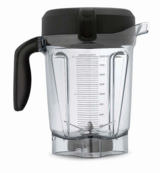Ein Mixer eignet sich besser zum Mischen von Flüssigkeiten, zum Zubereiten von Smoothies und zum Pürieren von weichen Lebensmitteln. Eine Küchenmaschine eignet sich besser zum Schneiden, Reiben, Hacken und Kneten und kann mit härteren Lebensmitteln umgehen.
Contents
Vergleichstabelle
| Mixer | Küchenmaschine | |
|---|---|---|
 |
 |
|
| Funktion | Mischen / Mischen, Pürieren, Herstellen von groben oder klobigen Pasten; Einige haben Eiszerkleinerungsfähigkeiten. | Hacken, schneiden, reiben, mischen, pürieren, Teig kneten |
| Entwarf zu mischen | Soft foods | Soft and hard foods |
| Capacity | Usually 4-8 cups | Usually over 9 cups, though there are 3-4 cup mini food processors |
| Design | Mostly cylindrical, relatively long and narrow | Larger cylinder, stubbier and wider in appearance |
| Blade | Single | Multiple, changeable blades for distinct functions |
Features
A blender usually has only one blade. The same blade is made to perform a limited set of functions by varying speed . While settings like chop and ice crush may fine-tune blending, the output may vary in texture (depending on the input), but will have little or no form. Blenders are mostly designed to blend liquid or soft foods into puree. Blenders are also the appliance to use when you want to crush ice.
A food processor on the other hand can perform several additional functions. It comes with a set of different types of blades, each one for a specific function. The processor can slice, chop and grate vegetables , and the output has a very defined form. Food processors can also knead dough for bread or pastry.
<iframe width=”450″ height=”338″ frameborder=”0″ allowfullscreen src=”https://www.youtube.com/embed/_J6oQCfYxrY?iv_load_policy=3&rel=0″></iframe>
Functions
A blender is primarily used to make soups, smoothies, sauces, dips and cocktails. Blenders mainly puree soft food , but a strong blender can also crush ice and coarsely chop or powder nuts.
A food processor performs specific multiple functions, such as chopping, grating, slicing, pureeing, kneading dough for bread or pastry, and making nut butter.
Form and Texture of Processed Food
The food processed in a blender can have different textures, but is provides much better consistency than a food processor.
The food prepared in a food processor usually has a definite form according to its function (slices, shreds, diced etc.).
Popular Brands
Some of the top blender brands include familiar names like KitchenAid, Hamilton Beach, Oster, Black & Decker, Cuisinart, Magic Bullet and Vita-Mix .
The top food processor brands include Cuisinart, KitchenAid, Magimix, Dualit, Kenwood and Philips.
Price
For any specific brand, a food processor is slightly more expensive than a blender. However, both these small kitchen appliances fall in a comparable price range. Blenders range from $20 to $600, whereas the price for food processors may range from $40 to $800.
References
- Do you need a blender, a food processor, or both? – Consumer Reports
- Wikipedia:Food processor
- Consumer Reports blender buying guide
- Choosing the best Food Processor – reluctantgourmet.com
